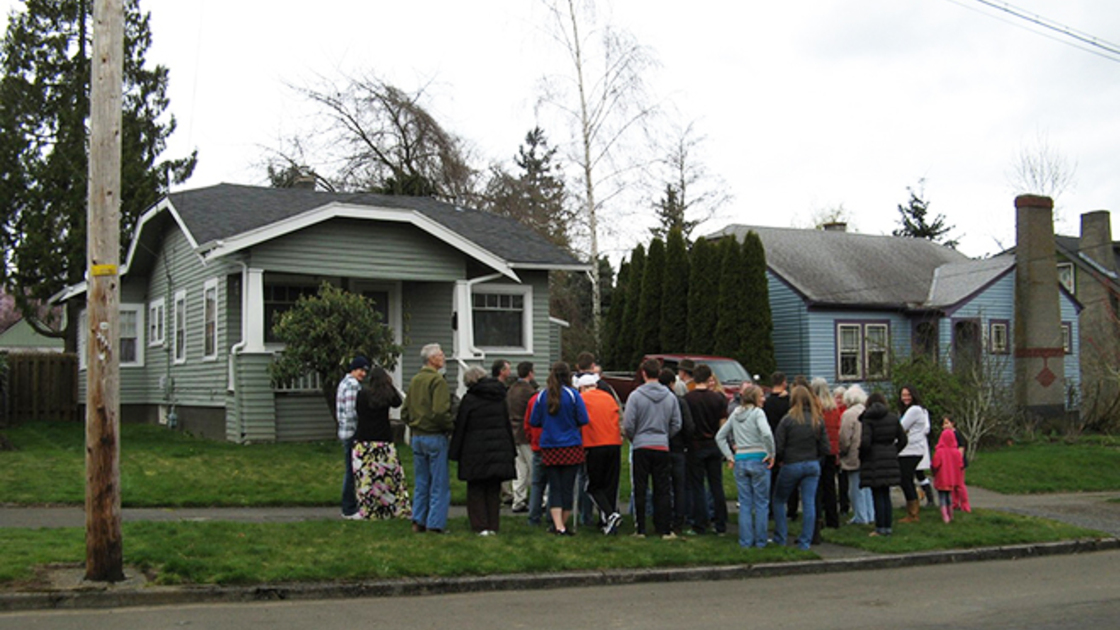OREGON—Members from the Northwest region gathered on March 16 for the year’s second church history tour of the landmarks from the early Philadelphia era of God’s Work. The group visited sites in the city of Portland, led by James Lowry and his wife, Jessica. The tours were put together through hours of research of Herbert W. Armstrong’s co-worker letters, articles and autobiography, as well as library microfiche, old newspaper clippings, phone books and advertisements.
“If Eugene was the birthplace of the Philadelphia work,” Mr. Armstrong wrote, “then Portland was where the gestation took place.”
The tour started with a 20-minute bus drive through Portland to the site of the Portland Gas and Coke Company, which is where Mr. Armstrong’s younger brother, Russell, worked at the time. The building west of downtown is now a moss-covered and dilapidated structure slated for demolition—a sight that members said reminded them of the great passage of time since the younger Armstrong worked there. It was while he was working there that Russell offered to buy his older brother a new overcoat, since his had a large hole. Mr. Armstrong recorded the incident in his autobiography. At first, he refused out of pride, but then he acquiesced when he remembered he had recently prayed that urgent 18-second prayer for God to provide several pressing needs, one of which was the coat.
“This is history coming alive before our eyes!” Debra Hamlin said.
The group boarded the bus and drove to the location of the former Meier & Frank store where Mr. Armstrong selected his coat (the building is now a Macy’s department store). They also visited the nearby Multnomah County Central Library where Mr. Armstrong conducted much of his six-month, day-and-night study on his “dual challenge” in 1926. “It is where he disproved evolution and proved the Sabbath was still binding. This was where he was actually converted,” Lowry explained. Members looked through old phonebooks and saw the names and addresses listed for Mr. Armstrong and his brother.
“God must have carefully directed him to show him what to look for,” deacon Bruce Young said. “There are so many books here.”
Teen Katie Schow said her favorite part of the tour was “the library! It’s where he actually studied.”
The group made several other stops and “drive-bys,” including the previous location of the kxl radio station, where Mr. Armstrong learned a lesson of stepping out in faith. When the opportunity to broadcast opened up, he hesitated to step through the open door because he had only half of the pledges necessary to pay for the additional station. The door closed, and did not reopen for two long years.
The next stop was the Portland Public Auditorium, where Mr. Armstrong assisted a man with a crooked spine who was hoping to be healed, another story which he included in his autobiography. The group left the auditorium and drove by the place where the man had lived. Lowry’s tour narrative continued: “When Mr. Armstrong was later driving nearby, a ‘mysterious force had turned the steering wheel against my will,’ down to this man’s house and he performed his first ‘public prayer,’ asking God to heal the man only of blood poisoning, but not the crooked spine. He was immediately healed of the blood poisoning, but still refused to obey God’s law. He never saw this man again.”
The tour stopped at two houses where the Armstrong family had lived. Lowry reminded members of what Mr. Armstrong wrote in his autobiography about the many miracles that happened there, including the “18-second prayer” asking for healing of his wife, much-needed food, firewood, money for a hospital bill and a new overcoat.
“This last house on 75th tied the tour all together, bringing it full circle,” member Beth Bruce said.
